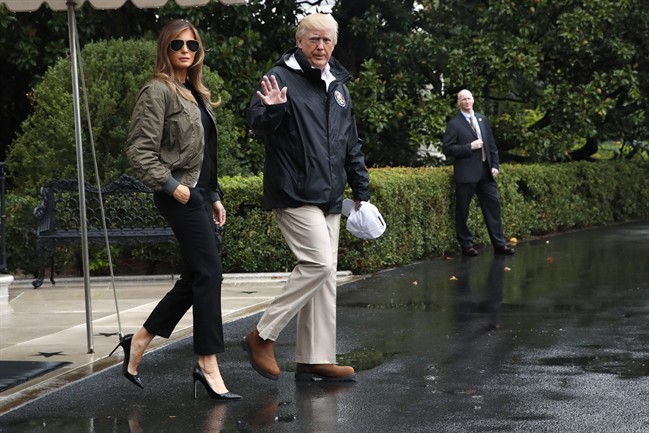
A question for my readers: what’s the point of sending U.S. President Donald Trump and First Lady Melania Trump (and her shoes, more on that later) to Texas at all? Why is this just something we accept as necessary, or even good?The devastation in Texas is appalling, of course. I am very fearful we might see a disaster similar to Katrina: as the waters recede, we could discover that hundreds or even thousands of people drowned in their homes. The storm is, astonishingly, not even finished yet; it’s still raining in parts of south Texas, and the system is now moving on to Louisiana. The cost in lives and money is currently unknown, but it’ll likely be painfully steep.READ MORE: Melania Trump’s office smacks down criticism of her shoes ahead of Harvey visitI grant all this. This is not intended, in any way, to downplay the danger and the devastation. But, again, I ask — why send the president? And this isn’t a uniquely American urge. Why do we need our prime minister to show up every time there’s flooding in Calgary or Quebec?This may sound churlish, but there is a bigger, broader point here: this is an impulse that I have never understood. Disasters aren’t reversed through cheerleading, but the determined and sustained work of professional response forces and the often heroic efforts of volunteers.If, God forbid, I ever find myself at the heart of a disaster, I will want supplies or, if necessary, a ride to somewhere safe and help getting settled in. I wouldn’t want a politician coming in to look around, sit around a table and give some statements.Send soldiers. Send sandbags. Send food and nurses. Skip the photo-op.Trump wasn’t wrong to come — he was in fact right to avoid Houston itself, where a presidential visit would have compounded the problems the personnel there already face. I don’t blame the politicians who show up. They’re expected to. I blame the people — all of us — who’ve come to expect it in the first place.READ MORE: Donald Trump visits Harvey-hit areas, promises full relief effortsI confess this is an awfully nitpicky thing to focus on. I assure you, I haven’t lost sight of the big picture. But this issue eats at me. I can’t tell you precisely why. It dates back, probably, to the Red River floods in 1997. Then-prime minister Jean Chrétien was lampooned after a photo-op gone awry; while visiting with volunteers and soldiers building sandbag berms in Winnipeg, Chrétien was handed a sandbag he had no idea what to do with. It was a horrible moment for the prime minister — the fact that I remember it 20 years later says something about how cringe-worthy it is (not that it stopped him from winning a few more elections).But even as Chrétien was slammed for being out of touch and disconnected from the disaster, a much younger me was thinking, “He’s the prime minister. Why does anyone expect him to be building berms?”It’s a question I’ve never heard a decent answer to. But I seem to be alone in my preference to politicians to stay away from disasters while the actual experts and volunteers do the work. The photo-op where the leader surveys the damage from airplane or helicopter, and meets with troops and Red Cross officials, and gives some utterly banal and predictable remarks, is part of the routine now. Should it be? No. But it is.But nothing comes of it. I can see why a politician rushes to show solidarity after an act of terrorism or other incidents of mass violence: there’s human agency there that can be countered through a positive example. But a presidential or prime ministerial visit to a natural disaster area doesn’t stop the fires or the rain. It doesn’t magically provide a few extra brigades of soldiers or a supply of clean water. Indeed, they can even distract from more important efforts and divert resources away from where they’re needed (again, this is why it’s good Trump avoided Houston itself).WATCH:
The people on the ground don’t benefit from it, and for the politician, there’s risk to the visits. In Winnipeg in 1997, it was a sandbag tossed at an unsuspecting Jean Chrétien. In 2013, it was Stephen Harper getting grilled for wearing an Air Force flight jacket while touring a flooded-out Calgary. This week, it was a brief and ridiculous barrage of criticism aimed at the First Lady over her shoes: while walking out of the White House to begin the journey to Texas, she was photographed wearing stylish but impractical stillettos.You can imagine the reaction online: Out of touch! Clueless! Elitist! Inexperienced! It was pathetic. When she arrived in Texas, the First Lady had changed into more practical footwear, which was always going to be the case.How stupid do you have to be to think it makes sense for someone to leave the White House already wearing the clothes you’ll tour a disaster area in. It’s like an astronaut driving to work every day wearing a spacesuit or a firefighter walking around the house with an axe over one shoulder and a hose on the other. Guys … wait til you get to the office, you know?It was an absurd and overblown story, as were the other ones. But that’s what happens when we dispatch public figures on entirely by-the-numbers visits to disaster areas. In the absence of anything useful to talk about, we talk about nothing. Like jackets and shoes.The situation along the U.S. Gulf Coast is serious. It could well prove devastating. Massive rescue efforts are still ongoing, and a major rebuilding effort will be needed.The job of the president of the United States is to contribute where possible, but mostly to stay out of the way.The job of the media (and the public more generally) is to stay focused on the rescue and rebuilding effort and do what they can to assist.Both those goals would be better served if America’s unconventional president makes mandatory visits to disaster the latest tradition he leaves by the wayside. Perhaps other leaders could then follow. We’d all be better off for that.Matt Gurney is host of The Morning Show on Toronto’s Talk Radio AM640 and a columnist for Global News.
© 2017 Global News, a division of Corus Entertainment Inc.











Comments